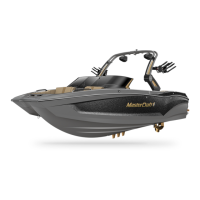Practice makes perfect! Start in calm water with no wind or current
and plenty of room until you get the feel for the boat and its controls.
Proceed slowly! Give yourself time to think, react and maneuver.
Recognize outside forces! Check the wind direction and velocity, as
well as water currents and waves.
Have a crew on hand! Have friends or family ready with fenders,
lines and a boat hook to assist you when docking, as well as
launching and loading.
Remember that a boat is not an automobile! Boats cannot be
maneuvered and stopped like a car. Boats steer from the stern
(rear) and have no brakes.
Basic Maneuvering
Steering response is dependent upon three (3) factors: rudder
position, motion and throttle. While cruising speed maneuvering is
relatively easy and takes little practice, slow-speed maneuvering is
far more difficult and requires time and practice to master.
With both steering and propulsion at the rear of the boat, the initia-
tion of a turn pushes the stern of the boat away from the direction
of the turn. The stern follows a larger turning circle than the bow.
This is especially important to remember when making maneuvers
within close quarters.
While the effects of unequal propeller thrust (torque steering), wind,
and current may not always be present, a practiced driver will use
them to his/ her advantage.
Unequal thrust is a phenomenon shared by all single-engine, pro-
peller- driven boats. With the rudder in the straight-ahead position,
a counterclockwise rotation propeller tends to cause the boat to
drive to port when going forward, and to starboard when going
backward.
At high speed, there is compensation for this effect, so that unequal
thrust is virtually non-existent. But, at slow speed—and especially
during backing— the effect can be very pronounced. This is the
main reason that most experienced drivers approach with the dock
to the starboard side of the boat.
Stopping—or checking headway—is a technique that must be
mastered. With no brakes, reverse must be used to stop the boat.
The momentum of the boat will vary according to the load. Make it a
practice to slow to in no-wake speed before shifting into reverse.
When practicing maneuvering techniques, always do so in open wa-
ter that is free of traffic. Adequate practice may make the difference
between a pleasurable boating experience or a potentially damag-
ing (at the very least, embarrassing) one.
High Speed Operation
MasterCraft boats are designed to accommodate professional
drivers with advanced operating skills who can perform high-speed
maneuvers and turns on-a-dime. DO NOT attempt to duplicate or
simulate these feats. Paid, professional drivers log thousands of
hours on the water and carefully choreograph every move. Plans are
made in advance in the event the routine must be aborted.

